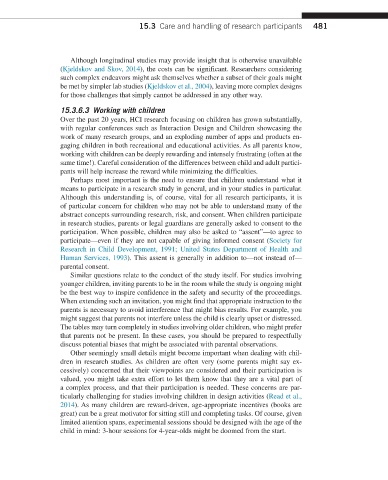Page 489 -
P. 489
15.3 Care and handling of research participants 481
Although longitudinal studies may provide insight that is otherwise unavailable
(Kjeldskov and Skov, 2014), the costs can be significant. Researchers considering
such complex endeavors might ask themselves whether a subset of their goals might
be met by simpler lab studies (Kjeldskov et al., 2004), leaving more complex designs
for those challenges that simply cannot be addressed in any other way.
15.3.6.3 Working with children
Over the past 20 years, HCI research focusing on children has grown substantially,
with regular conferences such as Interaction Design and Children showcasing the
work of many research groups, and an exploding number of apps and products en-
gaging children in both recreational and educational activities. As all parents know,
working with children can be deeply rewarding and intensely frustrating (often at the
same time!). Careful consideration of the differences between child and adult partici-
pants will help increase the reward while minimizing the difficulties.
Perhaps most important is the need to ensure that children understand what it
means to participate in a research study in general, and in your studies in particular.
Although this understanding is, of course, vital for all research participants, it is
of particular concern for children who may not be able to understand many of the
abstract concepts surrounding research, risk, and consent. When children participate
in research studies, parents or legal guardians are generally asked to consent to the
participation. When possible, children may also be asked to “assent”—to agree to
participate—even if they are not capable of giving informed consent (Society for
Research in Child Development, 1991; United States Department of Health and
Human Services, 1993). This assent is generally in addition to—not instead of—
parental consent.
Similar questions relate to the conduct of the study itself. For studies involving
younger children, inviting parents to be in the room while the study is ongoing might
be the best way to inspire confidence in the safety and security of the proceedings.
When extending such an invitation, you might find that appropriate instruction to the
parents is necessary to avoid interference that might bias results. For example, you
might suggest that parents not interfere unless the child is clearly upset or distressed.
The tables may turn completely in studies involving older children, who might prefer
that parents not be present. In these cases, you should be prepared to respectfully
discuss potential biases that might be associated with parental observations.
Other seemingly small details might become important when dealing with chil-
dren in research studies. As children are often very (some parents might say ex-
cessively) concerned that their viewpoints are considered and their participation is
valued, you might take extra effort to let them know that they are a vital part of
a complex process, and that their participation is needed. These concerns are par-
ticularly challenging for studies involving children in design activities (Read et al.,
2014). As many children are reward-driven, age-appropriate incentives (books are
great) can be a great motivator for sitting still and completing tasks. Of course, given
limited attention spans, experimental sessions should be designed with the age of the
child in mind: 3-hour sessions for 4-year-olds might be doomed from the start.

